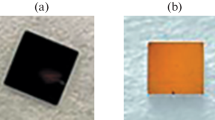Abstract
In the course of a systematic optimization of the materials properties of α-HgI2 crystals for room temperature γ- and X-ray detectors, we have investigated possible sources of defects and discuss briefly the possibility to supress them. Due to the particular structure of α-HgI2, large amount of impurities, particularly hydrocarbons, can be absorbed invan der Waals layers and lattice channels. Purification by sublimation does not work due to the affinity of hydrocarbons to iodine and their easy re-absorption in the sublimate. “Lattice filtering” of the large concentration of hydrocarbons contained even in “suprapure” iodine has been performed using the close spaced lattice of CuI. Oxidation of hydrocarbons by reaction of oxygen with HgI2 is another possibility for their removal.
Mass spectrometric investigations of a molecular beam of α-HgI2 has solved the long disputed problem of the existence of nonstoichiometry: both excess of Hg or excess of I are possible. The removal of nonstoichiometry can be achieved by suitable thermal treatment only in the case of pure crystals. In the presence of hydrocarbons, the non-stoichiometric defects are fixed showing the predominant importance of hydrocarbons for α-HgI2.
Investigation of the evaporation of α-HgI2 with mass spectrometry at low temperatures (150>T>40 °C) shows a strong change of the enthalpy of evalporation at 67 °C whereas DSC does not show any peak at this temperature. It seems probable that this is due to a surface reconstruction which influences the evaporation but not the thermal bulk lattice effects which are detected by DSC.
Zusammenfassung
Während einer systematischen Optimierung der Eigenschaften von α-HgI2 Kristallen für Zimmertemperatur γ- und X-Strahl-Detektoren haben wir die Ursachen von Defekten untersucht und die Möglichkeiten ihrer Eliminierung diskutiert. Als Folge der Schichtstruktur von α-HgI2 können große Mengen von Verunreinigungen, speziell Kohlenwasserstoffe, in denvan der Waals Schichten und Kanälen des Gitters absorbiert werden. Reinigung durch Sublimation ist nicht wirkungsvoll, da die Kohlenwasserstoffe eine große Affinität zum Jod haben und im Kondensat wieder absorbiert werden. Zur Beseitigung von Kohlenwasserstoffen, die sogar im Jod „Suprapur“ (Merck) enthalten sind, haben wir eine „Filtration“ durch das dicht gepackte Gitter von CuI durchgeführt. Die Oxidation von Kohlenwasserstoffen durch die Reaktion von HgI2 mit Sauerstoff ist eine andere Möglichkeit der Reinigung.
Massenspektrometrische Untersuchungen eines Molekularstrahles von HgI2 haben die seit langer Zeit erörterte Frage über die Nichtstöchiometrie von HgI2 beantwortet: sowohl Überschuß von Hg als auch Überschuß vom Jod sind möglich. Jedoch kann nur im Falle von reinem HgI2 Kristallen die Überschüssige Komponente durch eine thermische Behandlung beseitigt werden. In Anwesenheit von Kohlenwasserstoffen werden die nichtstöchiometrischen Defekte stabilisiert, was auf eine wichtige Rolle der Kohlenwasserstoffe hinweist.
Die Untersuchung der Verdampfung von HgI2 bei tieferen Temperaturen (150>t>40 °C) zeigt eine starke Änderung der Sublimationsenthalpie bei 67 °C, wobei kein Peak bei dieser Temperatur mittels DSC zu messen ist. Eine mögliche Erklärung ist, daß dieser Effekt durch eine Oberflächenrekonstruktion verursacht wird, die die Verdampfung, aber nicht die Volumeneigenschaften der Kristalle beeinflußt und deshalb durch DSC nicht nachgewiesen werden kann.
Similar content being viewed by others
References
Piechotka M,Kaldis E, Material aspects of α-HgI2 γ-ray detectors (to be published)
Kobayashi T, Muheim JT, Waegli P, Kaldis E (1983) J Electrochem Soc 130: 1183
Nicolau IF (1983) J Biochem Technol 33 A: 350
Kojima S, Tsukada K, Ogava S, Shimanchi A (1955) J Chem Phys 23: 1963
Huth GC (1979) Report USC-MISG 400-07, University of Southern California, Medical Imaging Science Group
Piechotka M, Kaldis E (1986) J Electrochem Soc 133: 200
Piechotka M,Muheim JT,Kaldis E in: Extended abstracts of the 7th international conference on crystal growth, Stuttgart, September 1983
Faile P, Dabrowski AJ, Huth GC, Iwanczyk JS (1980) J Cryst Growth 50: 752
Przyluski J, Laskowski J, Piechotka M (1984) Mat Res Bull 19: 189
Dworsky R, Komarek KL (1970) Monatsh Chem 101: 985
Burger A, Roth M, Schieber M (1982) J Cryst Growth 56: 526;
Dishon G, Schieber M, Ben-Dor L, Halitz L (1981) Mat Res Bull 16: 565
DeLong MC, Rosenberger F (1981) Mat Res Bull 16: 445
Nicolau IF, Rolland G (1981) Mat Res Bull 16: 759
Piechotka M, Kaldis E (1986) J Less Common Metals 115: 315
Lynn R (1984) EG + G Santa Barbara Operations, private communication, March 1984
Long NV,Kleinstück K,Tobisch J,Klinger P,Prokert K,Schuricht V (1983) Crystal Res Technol 18: K93
Schwarzenbach D (1969) Z Kristallographie 128: 87
Kohlschütter HW (1927) Kolloidchem Beih 24: 319
Kleber W, Raidt H, Leupold KO (1983) Kristall und Technik 3: 65
Yelon WB, Alkire RW, Schieber MM, van den Berg L, Rasmussen SE, Christensen H, Schneider JR (1981) J Appl Phys 52: 4604
van den Berg L (1985) EG + G Santa Barbara Operations, private communication, October 1985
Author information
Authors and Affiliations
Additional information
Dedicated to Prof. Dr.K. L. Komarek at the occasion his 60th birthday.
Rights and permissions
About this article
Cite this article
Piechotka, M., Kaldis, E. Some sources of defects in α-HgI2, the room temperature γ-ray detector. Monatsh Chem 118, 137–153 (1987). https://doi.org/10.1007/BF00810048
Received:
Accepted:
Issue Date:
DOI: https://doi.org/10.1007/BF00810048




